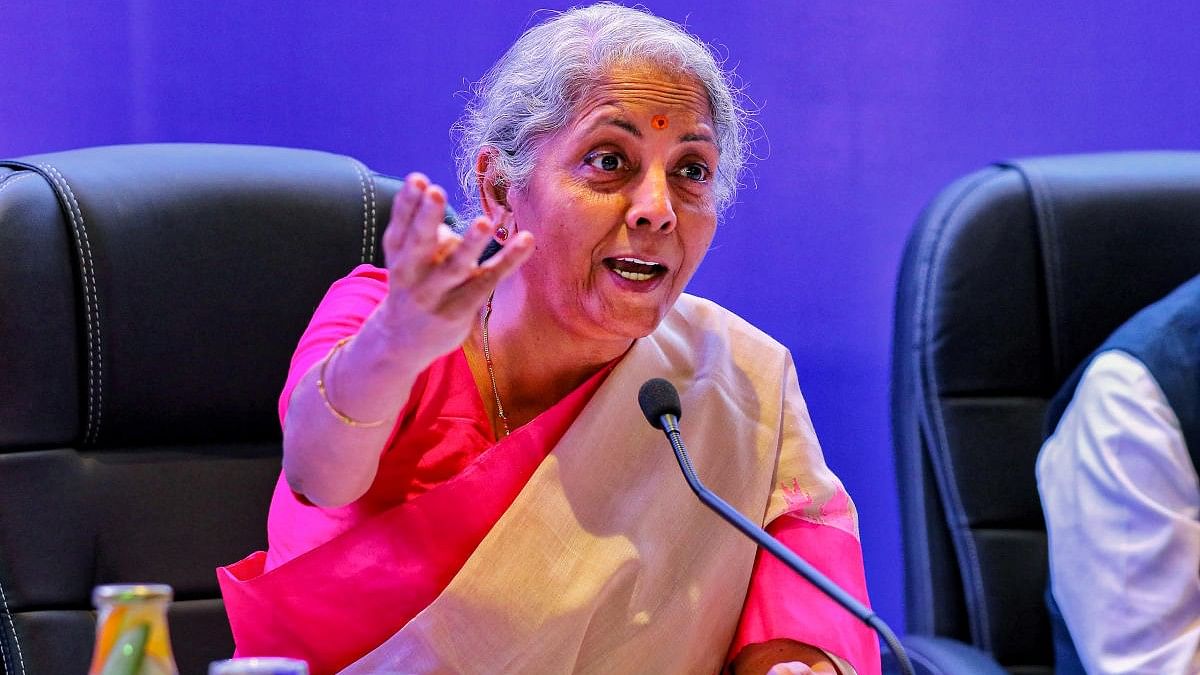
Finance Minister Nirmala Sitharaman.
Credit: PTI Photo
The 2023-2024 Budget provided Rs 10 lakh crore of capital expenditure out of the total budget of Rs 45 lakh crore. During these five years, the Narendra Modi government allocated a total capex of Rs 30,80,000 crore.
Though a good deal of the capex was loans and advances, artificial capex for writing down losses of Air India/BSNL and substituted capex of railways and the NHAI, increasing budgetary capex has become the political trump card of the government.
With the interim budget for 2024-2025 only a few days away, it is good to look at the details of the hype and reality of Modi 2.0’s capital expenditure, and ask: Will the government give a big hike to capex yet again? Are there real economic benefits of capex? If yes, who benefits?
Trophy assets
Of the Rs 10 lakh crore capex budget in 2023-2024, Rs 2,70,000 crore was for building expressways, highways, and other roads. Rs 2,40,000 crore was for constructing rail infrastructure and procurement of rolling stock to launch new trains, such as the Vande Bharat. The Rs 1,63,000 crore defence capital outlay was to fund the acquisition of fighter jets, naval ships, missiles, and other defence equipment. Rs 1,30,000 crore went in 50-year interest-free loans to states to nudge them to undertake capital expenditure which the Union government preferred to tie their hands with.
The rest went for equity support for the BSNL to pay back 4G/5G licence fees, to oil marketing companies to fund losses from stalled prices, financing metro rail projects, and the like.
The government capex built highly-visible trophy assets available for the Prime Minister to grandly lay foundation stones and inaugurate.
Railways capex is not delivering growth
The railways has, over the years, come to have a very small share in transport sector’s gross value added (GVA) — passenger and freight revenues minus inputs except labour cost — and has been constantly losing it.
The railways’ GVA, as per national accounts, was 16.15 per cent in 2013-2014 (Rs 73,685 crore out Rs 4,56,000 crore). It declined consistently in Modi’s tenure — to 14.43 per cent in 2018-2019 (Rs 91,350 crore out of Rs 6,20,000 crore) and further to 13.3 per cent in 2021-2022 (Rs 83,107 crore out of Rs 6,25,000 crore).
The big railway capex is contributing only to worsening the GVA to gross capital formation (GCF) ratio, which means there is increasingly less output from the investment made.
This ratio was 173 per cent in 2013-2014 (GCF Rs 42,700 crore). The ratio deteriorated to 125 per cent in 2018-2019 (GCF Rs 73,000 crore) and fell to 92 per cent in 2021-2022 (GCF Rs 90,100 crore). Almost 50 per cent capital efficiency loss in eight years!
Carried passengers and freight share and income are not increasing. Is railway capex largely wasteful economically?
Cost doubling
The government approved the Bharatmala Pariyojana Phase-I (aggregate length of 34,800 km) in October 2017 with an outlay of Rs 5,35,000 crore, to be completed by 2021-2022. The original deadline has long gone.
MoRTH’s Annual Report 2022-2023 informs that only 11,789 kilometre of Bharatmala project was completed until December 2022—that is less than one-third of the target. The road projects of 25,713 kilometre, awarded with a total capital cost of Rs 7,81,000 crore, also fell short.
The project faced steep time and cost overruns. The department of expenditure asked, in November, MoRTH not to create any new liability under Bharatmala. MoRTH reportedly prepared a cabinet note with a revised cost of Rs 10.6 trillion for completing the project, which is almost double the originally approved cost!
The high capex in roadways, instead, has made two major casualties in the sector.
The Build, Operate, Transfer (BOT) mode, which brings private capital and entrepreneurship, has disappeared, replaced by capex-guzzling engineering, procurement, and construction (EPC) mode and hybrid annuity mode (HAM).
The NHAI debt crossed Rs 3,49,000 crore in 2021-2022, almost doubling from 2018-2019. From 2022-2023, the government stopped a bankrupt NHAI from taking any loans. It is all government capex thereafter.
Big industry gains
Huge government capex in railways and roads raises the demand for cement, steel, and other construction material and machinery — automatic railway track-laying machines and asphalt mixing machines, and road rollers for road construction. There is very little of labour use.
While understandable from efficiency and quality perspective, this highly capital-intensive mode of constructing these assets delivers the budget capex and profits to the industrial corporates. No wonder big industry associations are clamouring for increasing the capex budget. Growing corporate profits partly explain rising corporate tax revenues. The equation is mutually reinforcing.
It is no coincidence that the capex budget almost equals total corporate tax receipts. This could also mean that more political donations in electoral bonds come in.
Capex will see good increase
The capex creates big trophy assets mesmerising the public. These big-ticket projects are likely to influence their political choices as well.
Normally, the right occasion to present a capex plan for 2024-2025 is the regular budget which will be presented in July.
The convergence of the interest of powerful corporates and the political party in power will, however, drive another big boost in the capital expenditure budget when Nirmala Sitharaman presents her interim budget on February 1.
I would be surprised if the capex for 2024-2025 does not cross Rs 12,50,000 crore.
(Subhash Chandra Garg is former Finance & Economic Affairs Secretary, and author of ‘The Ten Trillion Dream’ and ‘We Also Make Policy’.)
Disclaimer: The views expressed above are the author's own. They do not necessarily reflect the views of DH.